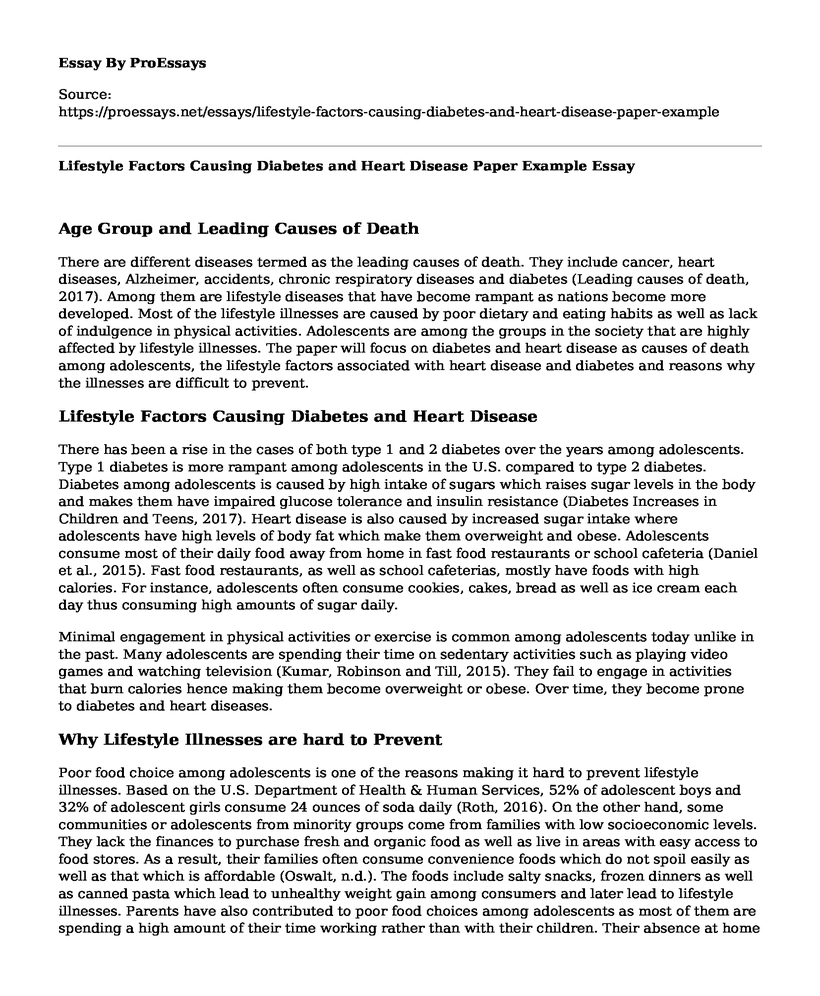Age Group and Leading Causes of Death
There are different diseases termed as the leading causes of death. They include cancer, heart diseases, Alzheimer, accidents, chronic respiratory diseases and diabetes (Leading causes of death, 2017). Among them are lifestyle diseases that have become rampant as nations become more developed. Most of the lifestyle illnesses are caused by poor dietary and eating habits as well as lack of indulgence in physical activities. Adolescents are among the groups in the society that are highly affected by lifestyle illnesses. The paper will focus on diabetes and heart disease as causes of death among adolescents, the lifestyle factors associated with heart disease and diabetes and reasons why the illnesses are difficult to prevent.
Lifestyle Factors Causing Diabetes and Heart Disease
There has been a rise in the cases of both type 1 and 2 diabetes over the years among adolescents. Type 1 diabetes is more rampant among adolescents in the U.S. compared to type 2 diabetes. Diabetes among adolescents is caused by high intake of sugars which raises sugar levels in the body and makes them have impaired glucose tolerance and insulin resistance (Diabetes Increases in Children and Teens, 2017). Heart disease is also caused by increased sugar intake where adolescents have high levels of body fat which make them overweight and obese. Adolescents consume most of their daily food away from home in fast food restaurants or school cafeteria (Daniel et al., 2015). Fast food restaurants, as well as school cafeterias, mostly have foods with high calories. For instance, adolescents often consume cookies, cakes, bread as well as ice cream each day thus consuming high amounts of sugar daily.
Minimal engagement in physical activities or exercise is common among adolescents today unlike in the past. Many adolescents are spending their time on sedentary activities such as playing video games and watching television (Kumar, Robinson and Till, 2015). They fail to engage in activities that burn calories hence making them become overweight or obese. Over time, they become prone to diabetes and heart diseases.
Why Lifestyle Illnesses are hard to Prevent
Poor food choice among adolescents is one of the reasons making it hard to prevent lifestyle illnesses. Based on the U.S. Department of Health & Human Services, 52% of adolescent boys and 32% of adolescent girls consume 24 ounces of soda daily (Roth, 2016). On the other hand, some communities or adolescents from minority groups come from families with low socioeconomic levels. They lack the finances to purchase fresh and organic food as well as live in areas with easy access to food stores. As a result, their families often consume convenience foods which do not spoil easily as well as that which is affordable (Oswalt, n.d.). The foods include salty snacks, frozen dinners as well as canned pasta which lead to unhealthy weight gain among consumers and later lead to lifestyle illnesses. Parents have also contributed to poor food choices among adolescents as most of them are spending a high amount of their time working rather than with their children. Their absence at home influences them to ask their children to purchase food or prepare simple meals, which may at times be unhealthy, and if consumed often, it can lead to lifestyle diseases.
There are various activities that prevent adolescents from taking part in physical activities. Many adolescents are using their free time playing video games or on the internet unlike in the past where they engaged in active hobbies and games (Kumar, Robinson and Till, 2015). Some of them also have part-time jobs and homework which they do during their free time. Therefore, the activities that adolescents engage in during their free time inhibit their participation in exercise. As a result, they gain unhealthy weight, which makes them prone to lifestyle illnesses such as diabetes and cardiovascular disease.
References
Daniel, C. L., Emmons, K. M., Fasciano, K., Nevidjon, B., Fuemmeler, B. F., & Demark-Wahnefried, W. (2015). Needs and lifestyle challenges of adolescents and young adults with cancer: summary of an Institute of Medicine and Livestrong Foundation Workshop. Clinical journal of oncology nursing, 19(6), 675.
Diabetes Increases in Children and Teens. (2017). Retrieved from https://newsinhealth.nih.gov/2017/06/diabetes-increases-children-teens
Kumar, B., Robinson, R., & Till, S. (2015). Physical activity and health in adolescence. Clinical Medicine, 15(3), 267-272.
Leading causes of death. (2017). Retrieved from https://www.cdc.gov/nchs/fastats/leading-causes-of-death.htm
Oswalt, A. n.d. Common Nutritional Challenges for Teenagers: Adolescent Diabetes. Retrieved from https://www.mentalhelp.net/articles/common-nutritional-challenges-for-teenagers-adolescent-diabetes/
Roth, E. (2016). Childhood Obesity: Causes, Risks, and Outlook. Retrieved from https://www.healthline.com/health/weight-loss/weight-problems-in-children#risk-factors
Cite this page
Lifestyle Factors Causing Diabetes and Heart Disease Paper Example. (2022, Sep 15). Retrieved from https://proessays.net/essays/lifestyle-factors-causing-diabetes-and-heart-disease-paper-example
If you are the original author of this essay and no longer wish to have it published on the ProEssays website, please click below to request its removal:
- Summer Sleep-Away Camp Essay
- The Theme of Silence in Woman Warrior - Critical Essay
- Essay Sample on Micro-Linguistics and Macro-Linguistics
- Essay Example on Nurturing Young Minds: Unlocking Brilliance in Kids Ages 2-8
- Essay on 125,000+ Infected, 4,600+ Dead: Preparing for the Global COVID-19 Crisis
- Essay Example on Prescription Drug Abuse: A Growing Public Health Crisis
- Free Report Sample on Obesity in the Workplace: Potential Adverse Effects and How to Manage







